Abstract
Numerous reports have illustrated the versatility of polychlorinated biphenyls (PCBs) and related halogenated aromatics as inducers of drug-metabolizing enzymes and the activity of individual compounds are remarkably dependent on structure. The most active PCB congeners, 3,4,4′,5-tetra-, 3,3′,4,4′-tetra-, 3,3′,4,4′,5-penta- and 3,3′,4,4′,5,5′-hexachlorobiphenyl, are substituted at both para and at two or more meta positions. The four coplanar PCBs resembled 3-methylcholanthrene (3-MC) and 2,3,7,8-tetrachlorodibenzo-p-dioxin (2,3,7,8-TCDD) in their mode of induction of the hepatic drug-metabolizing enzymes. These compounds induced rat hepatic microsomal benzo(a)pyrene hydroxylase (aryl hydrocarbon hydroxylase, AHH) and cytochromes P-450a, P-450c and P-450d. 3,4,4′,5-Tetrachlorobiphenyl, the least active coplanar PCB, also induced dimethylaminoantipyrine N-demethylase and cytochromes P-450b+e and resembled Aroclor 1254 as an inducer of the mixed-function oxidase system. Like Aroclor 1254, all the mono-ortho- and at least eight di-ortho-chloro analogs of the coplanar PCBs exhibited a “mixed-type” induction pattern and induced microsomal AHH, dimethylaminoantipyrine NM-demethylase and cytochromes P-450a–P-450e. Quantative structure–activity relationships (QSARs) within this series of PCBs were determined by comparing their AHH induction potencies (EC50) in rat hepatoma H-4-II-E cells and their binding affinities (ED50) for the 2,3,7,8-TCDD cytosolic receptor protein. The results showed that there was an excellent correlation between AHH induction potencies and receptor binding avidities of these compounds and the order of activity was coplanar PCBs (3,3′,4,4′-tetra-, 3,3′,4,4′,5-penta- and 3,3′,4,4′,5,5′-hexachlorobiphenyls) > 3,4,4′,5-tetrachlorobiphenyl ~ mono-ortho coplanar PCBs > di-ortho coplanar PCBs. It was also apparent that the relative toxicities of this group of PCBs paralleled their biological potencies.
The coplanar and mono-ortho coplanar PCBs also exhibit differential effects in the inbred C57BL/6J and DBA/2J mice. These compounds induce AHH and cause thymic atrophy in the former “responsive” mice whereas at comparable or higher doses none of these effects are observed in the nonresponsive DBD/2J mice. Since the responsiveness of these two mice strains is due to the presence of the Ah receptor protein in the C57BL/6J mice and its relatively low concentration in the DBA/2J mice, the results for the PCB cogeners support the proposed receptor-mediated mechanism of action.
Although the precise structural requirements for ligand binding to the receptor have not been delineated, the halogenated aromatic hydrocarbons which exhibit the highest binding affinities for the receptor protein are approximate isostereomers of 2,3,7,8-TCDD. 2,3,4,4′,5-Pentachlorobiphenyl elicits effects which are qualitatively similar to that of TCDD and the presence of the lateral 4′-substituent is required for this activity. Thus the 4′-substituted 2,3,4,5-tetrachlorobiphenyls have been used as probes for determining the substituent characteristics which favor binding to the receptor protein. Multiple regression analysis of the competitive binding EC50 values for 13 substituents gave the following equation: log (1/EC50) = 1.53σ + 1.47π + 1.09 HB + 4.08 where σ is electronegativity, π is hydrophobicity, HB is hydrogen bonding and r is the correlation coefficient (r = 0.978). The utility of this equation in describing ligand:receptor interactions and correlations with toxicity are being studied with other halogenated hydrocarbons and PAHs.
Full text
PDF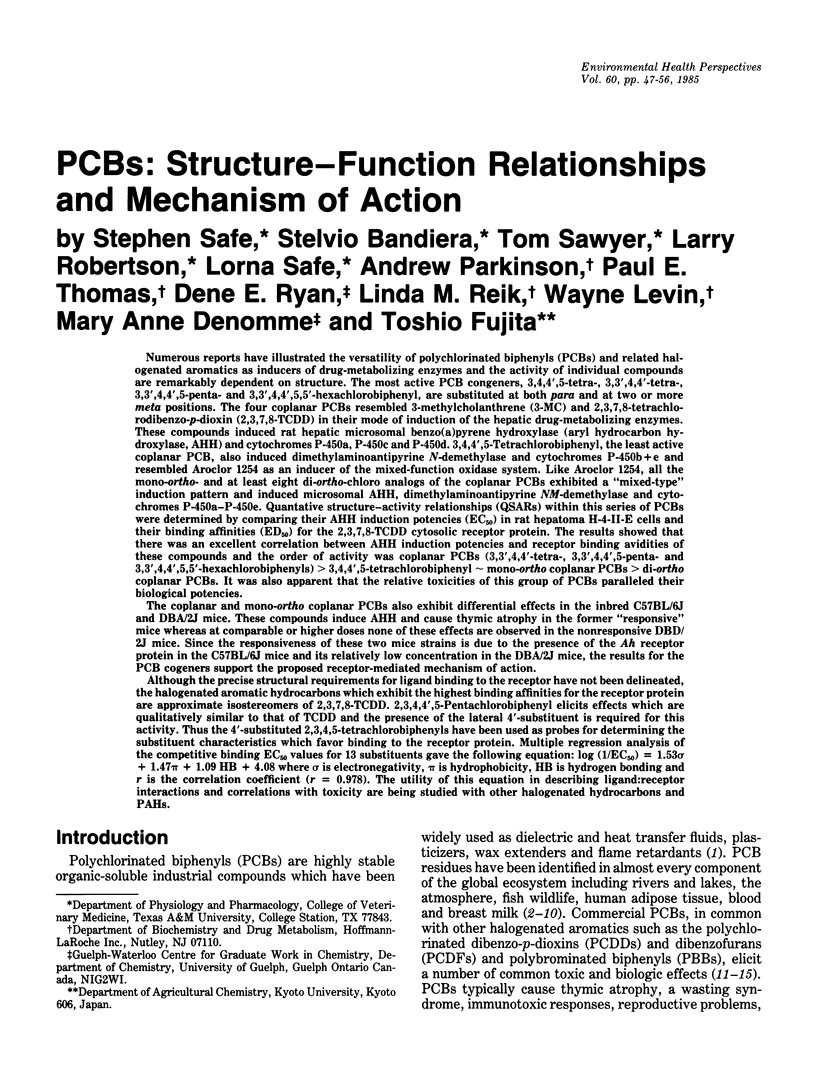
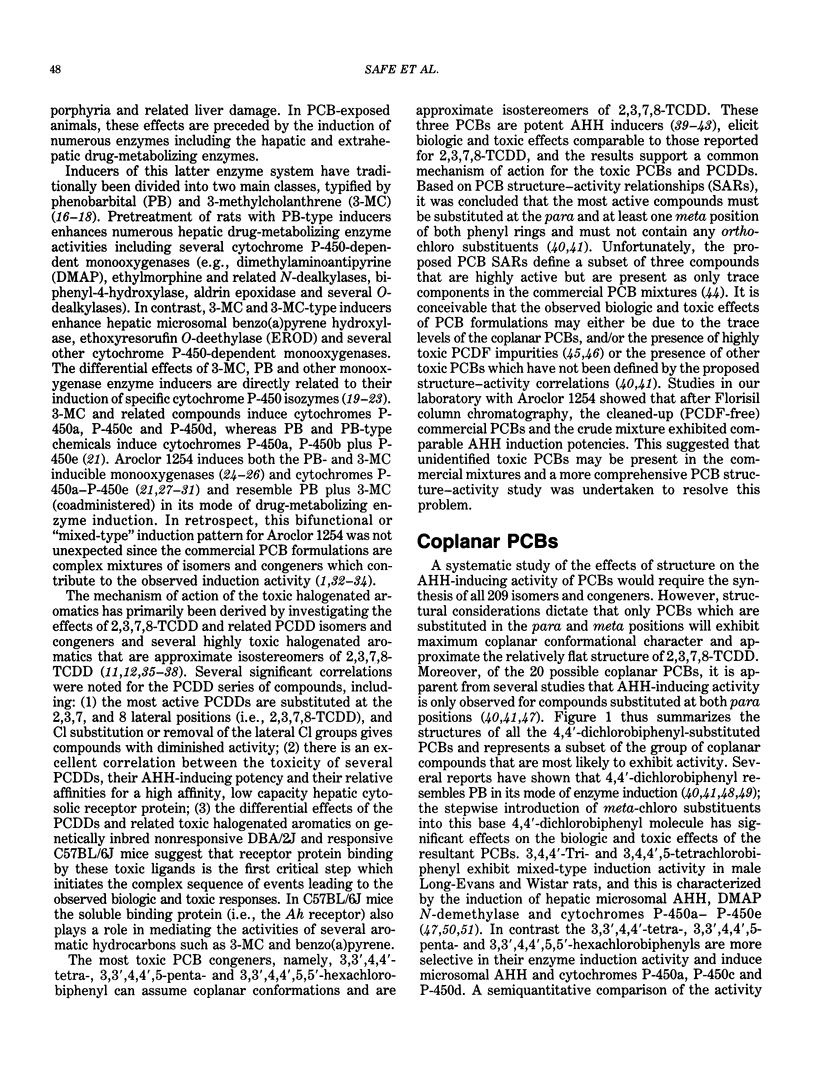
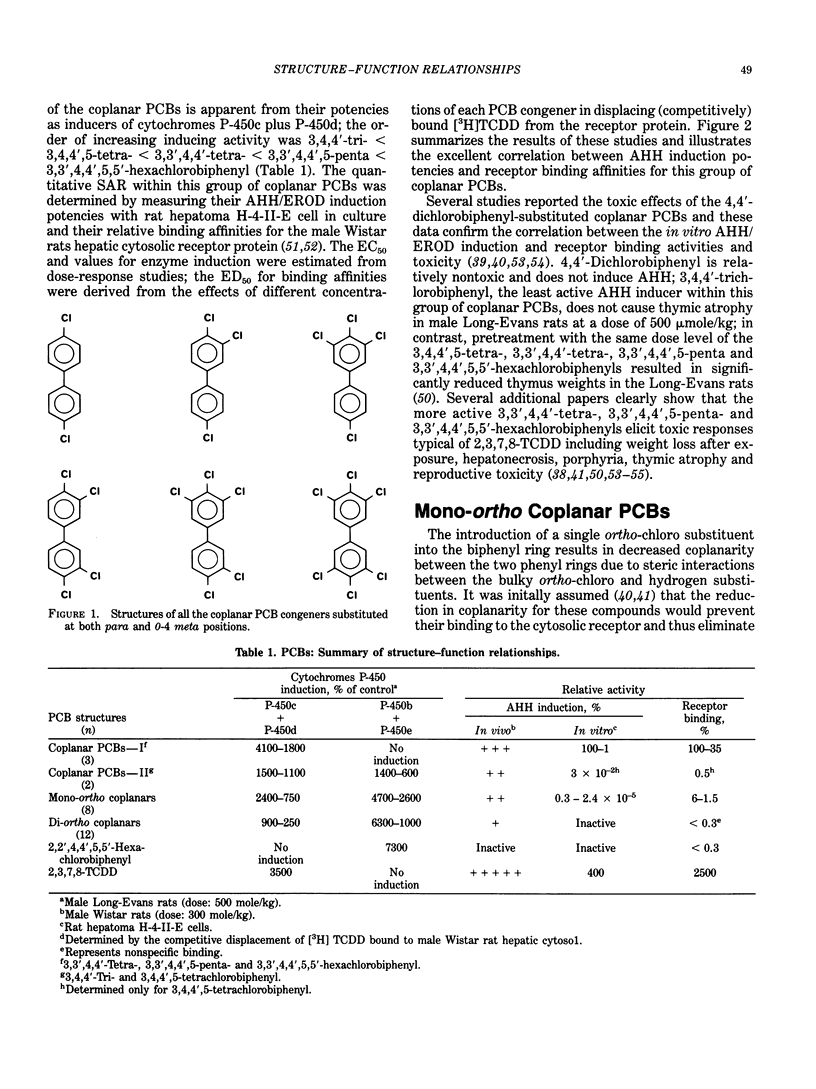
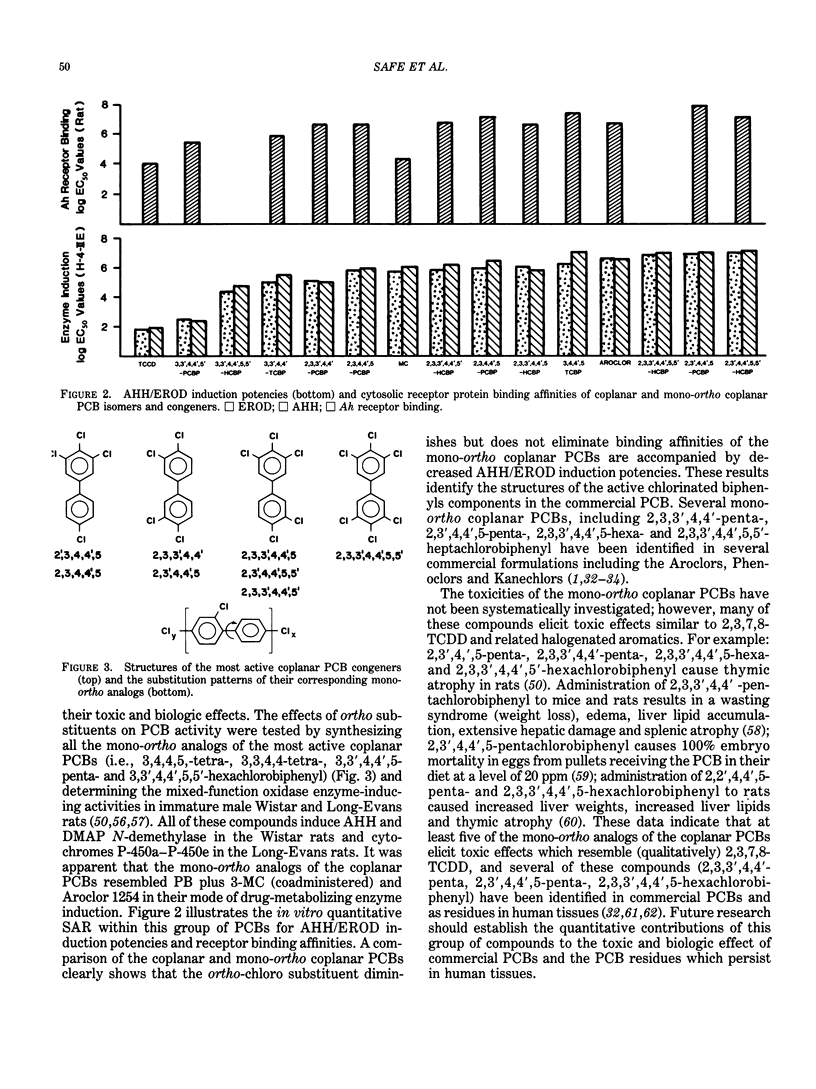

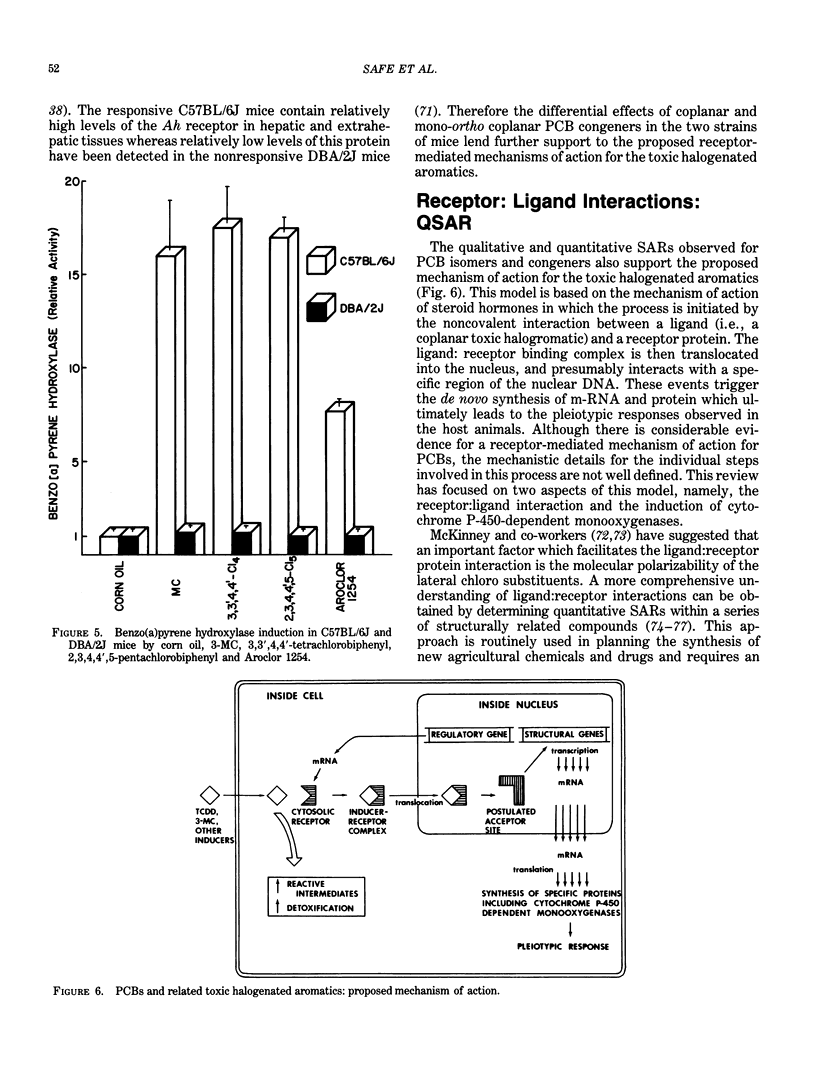
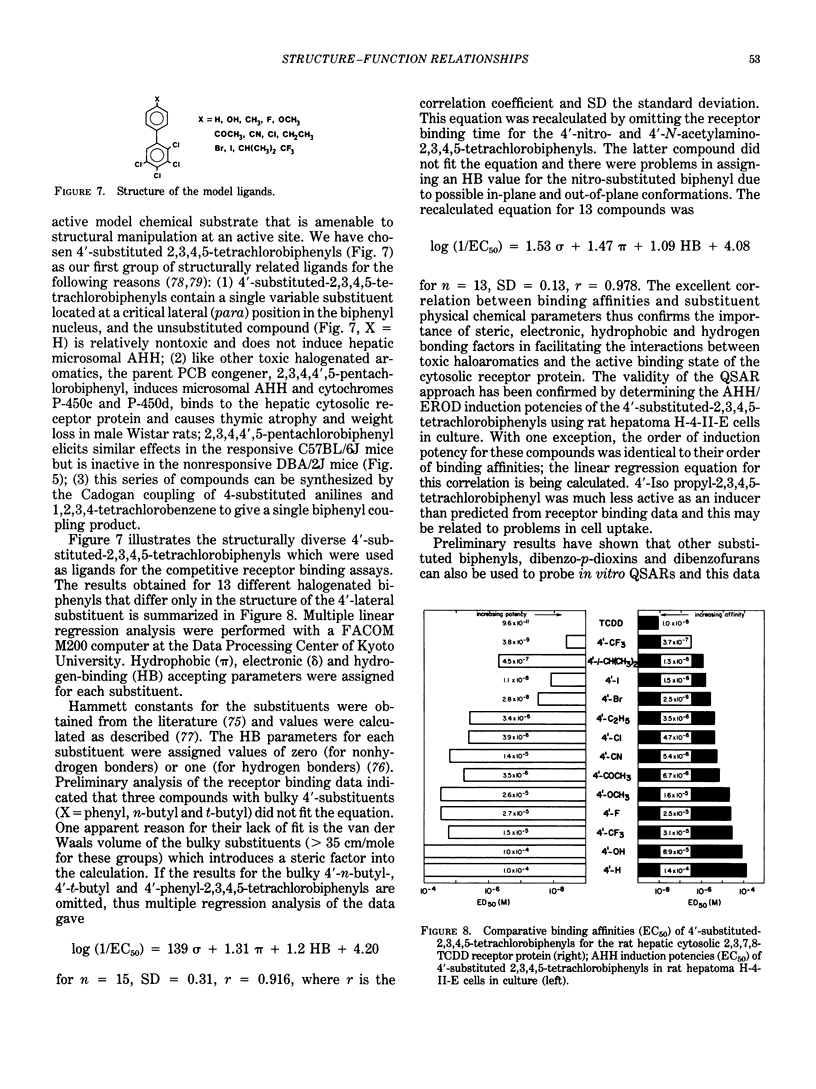

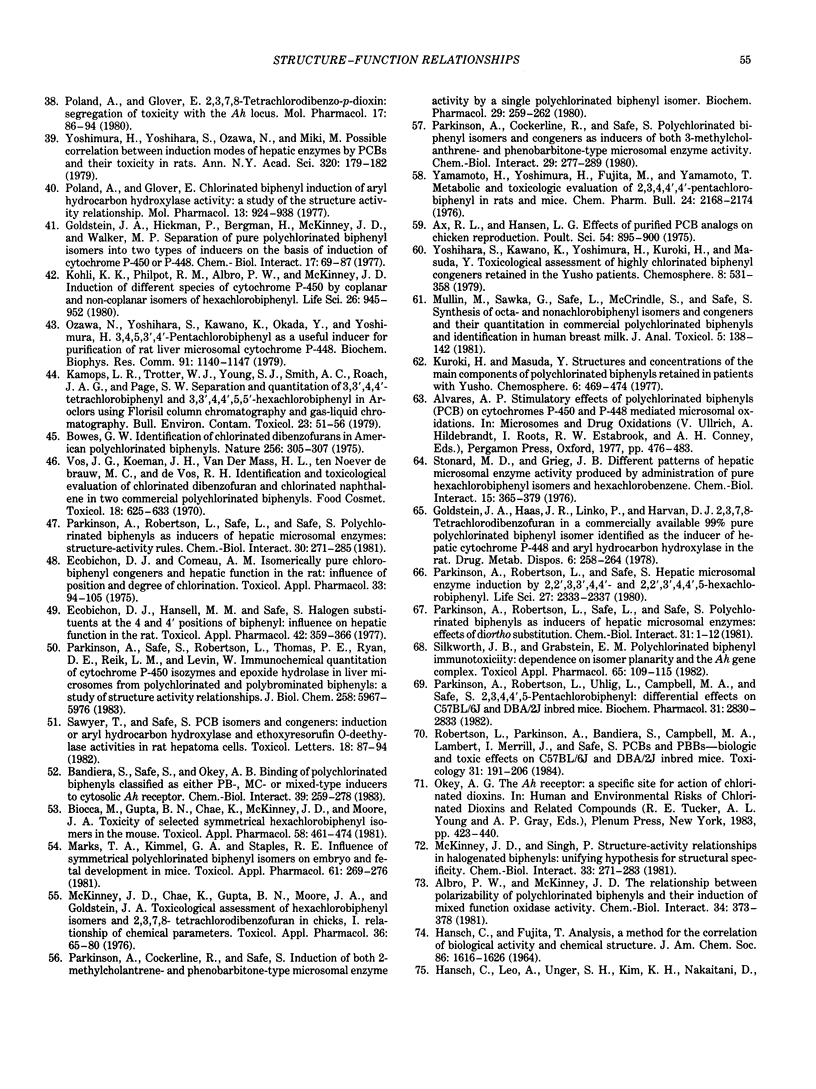

Selected References
These references are in PubMed. This may not be the complete list of references from this article.
- Albro P. W., McKinney J. D. The relationship between polarizability of polychlorinated biphenyls and their induction of mixed function oxidase activity. Chem Biol Interact. 1981 Mar 15;34(3):373–378. doi: 10.1016/0009-2797(81)90109-5. [DOI] [PubMed] [Google Scholar]
- Alvares A. P., Bickers D. R., Kappas A. Polychlorinated biphenyls: a new type of inducer of cytochrome P-448 in the liver. Proc Natl Acad Sci U S A. 1973 May;70(5):1321–1325. doi: 10.1073/pnas.70.5.1321. [DOI] [PMC free article] [PubMed] [Google Scholar]
- Alvares A. P., Kappas A. Heterogeneity of cytochrome P-450s induced by polychlorinated biphenyls. J Biol Chem. 1977 Sep 25;252(18):6373–6378. [PubMed] [Google Scholar]
- Alvares A. P., Kappas A. The inducing properties of polychlorinated biphenyls on hepatic monooxygenases. Clin Pharmacol Ther. 1977 Nov;22(5 Pt 2):809–816. doi: 10.1002/cpt1977225part2809. [DOI] [PubMed] [Google Scholar]
- Ax R. L., Hansen L. G. Effects of purified polychlorinated biphenyl analogs on chicken reproduction. Poult Sci. 1975 May;54(3):895–900. doi: 10.3382/ps.0540895. [DOI] [PubMed] [Google Scholar]
- Bandiera S., Safe S., Okey A. B. Binding of polychlorinated biphenyls classified as either phenobarbitone-, 3-methylcholanthrene- or mixed-type inducers to cytosolic Ah receptor. Chem Biol Interact. 1982 Apr;39(3):259–277. doi: 10.1016/0009-2797(82)90045-x. [DOI] [PubMed] [Google Scholar]
- Bandiera S., Sawyer T., Campbell M. A., Robertson L., Safe S. Halogenated biphenyls as AHH inducers: effects of different halogen substituents. Life Sci. 1982 Aug 9;31(6):517–525. doi: 10.1016/0024-3205(82)90479-9. [DOI] [PubMed] [Google Scholar]
- Biocca M., Gupta B. N., Chae K., McKinney J. D., Moore J. A. Toxicity of selected symmetrical hexachlorobiphenyl isomers in the mouse. Toxicol Appl Pharmacol. 1981 May;58(3):461–474. doi: 10.1016/0041-008x(81)90099-5. [DOI] [PubMed] [Google Scholar]
- Botelho L. H., Ryan D. E., Levin W. Amino acid compositions and partial amino acid sequences of three highly purified forms of liver microsomal cytochrome P-450 from rats treated with polychlorinated biphenyls, phenobarbital, or 3-methylcholanthrene. J Biol Chem. 1979 Jul 10;254(13):5635–5640. [PubMed] [Google Scholar]
- Bowes C. W., Mulvihill M. J., Simoneit B. R., Burlingame A. L., Risebrough R. W. Identification of chlorinated dibenzofurans in American polychlorinated biphenyls. Nature. 1975 Jul 24;256(5515):305–307. doi: 10.1038/256305b0. [DOI] [PubMed] [Google Scholar]
- Buckley E. H. Accumulation of airborne polychlorinated biphenyls in foliage. Science. 1982 Apr 30;216(4545):520–522. doi: 10.1126/science.216.4545.520. [DOI] [PubMed] [Google Scholar]
- Conney A. H. Induction of microsomal enzymes by foreign chemicals and carcinogenesis by polycyclic aromatic hydrocarbons: G. H. A. Clowes Memorial Lecture. Cancer Res. 1982 Dec;42(12):4875–4917. [PubMed] [Google Scholar]
- Conney A. H. Pharmacological implications of microsomal enzyme induction. Pharmacol Rev. 1967 Sep;19(3):317–366. [PubMed] [Google Scholar]
- Cordle F., Corneliussen P., Jelinek C., Hackley B., Lehman R., McLaughlin J., Rhoden R., Shapiro R. Human exposure to polychorinated biphenyls and polybrominated biphenyls. Environ Health Perspect. 1978 Jun;24:157–172. doi: 10.1289/ehp.7824157. [DOI] [PMC free article] [PubMed] [Google Scholar]
- Ecobichon D. J., Comeau A. M. Isomerically pure chlorobiphenyl congeners and hepatic function in the rat: influence of position and degree of chlorination. Toxicol Appl Pharmacol. 1975 Jul;33(1):94–105. doi: 10.1016/0041-008x(75)90248-3. [DOI] [PubMed] [Google Scholar]
- Ecobichon D. J., Hansell M. M., Safe S. Halogen substituents at the 4- and 4'-positions of biphenyl: influence on hepatic function in the rat. Toxicol Appl Pharmacol. 1977 Nov;42(2):359–366. doi: 10.1016/0041-008x(77)90013-8. [DOI] [PubMed] [Google Scholar]
- Fishbein L. Chromatographic and biological aspects of polychlorinated biphenyls. J Chromatogr. 1972 Jun 7;68(2):345–426. doi: 10.1016/s0021-9673(00)85724-6. [DOI] [PubMed] [Google Scholar]
- Fujita T., Nishioka T., Nakajima M. Hydrogen-bonding parameter and its significance in quantitative structure--activity studies. J Med Chem. 1977 Aug;20(8):1071–1081. doi: 10.1021/jm00218a017. [DOI] [PubMed] [Google Scholar]
- Goldstein J. A., Hass J. R., Linko P., Harvan D. J. 2,3,7,8-Tetrachlorodibenzofuran in a commercially available 99% pure polychlorinated biphenyl isomer identified as the inducer of hepatic cytochrome P-448 and aryl hydrocarbon hydroxylase in the rat. Drug Metab Dispos. 1978 May-Jun;6(3):258–264. [PubMed] [Google Scholar]
- Goldstein J. A., Hickman P., Bergman H., McKinney J. D., Walker M. P. Separation of pure polychlorinated biphenyl isomers into two types of inducers on the basis of induction of cytochrome P-450 or P-448. Chem Biol Interact. 1977 Apr;17(1):69–87. doi: 10.1016/0009-2797(77)90073-4. [DOI] [PubMed] [Google Scholar]
- Guengerich F. P., Dannan G. A., Wright S. T., Martin M. V., Kaminsky L. S. Purification and characterization of microsomal cytochrome P-450s. Xenobiotica. 1982 Nov;12(11):701–716. doi: 10.3109/00498258209038945. [DOI] [PubMed] [Google Scholar]
- Guengerich F. P. Isolation and purification of cytochrome P-450, and the existence of multiple forms. Pharmacol Ther. 1979;6(1):99–121. doi: 10.1016/0163-7258(79)90057-3. [DOI] [PubMed] [Google Scholar]
- HANSCH C., DEUTSCH E. W., SMITH R. N. THE USE OF SUBSTITUENT CONSTANTS AND REGRESSION ANALYSIS IN THE STUDY OF ENZYMATIC REACTION MECHANISMS. J Am Chem Soc. 1965 Jun 20;87:2738–2742. doi: 10.1021/ja01090a035. [DOI] [PubMed] [Google Scholar]
- Holdrinet M. V., Braun H. E., Frank R., Stopps G. J., Smout M. S., McWade J. W. Organochlorine residues in human adipose tissue and milk from Ontario residents, 1969-- 1974. Can J Public Health. 1977 Jan-Feb;68(1):74–80. [PubMed] [Google Scholar]
- Kamops L. R., Trotter W. J., Young S. J., Smith A. C., Roach J. A., Page S. W. Separation and quantitation of 3,3',4,4'-tetrachlorobiphenyl and 3,3',4,4',5,5'-hexachlorobiphenyl in aroclors using florisil column chromatography and gas-liquid chromatography. Bull Environ Contam Toxicol. 1979 Sep;23(1-2):51–56. doi: 10.1007/BF01769915. [DOI] [PubMed] [Google Scholar]
- Kimbrough R. D. The toxicity of polychlorinated polycyclic compounds and related chemicals. CRC Crit Rev Toxicol. 1974 Jan;2(4):445–498. doi: 10.3109/10408447309025705. [DOI] [PubMed] [Google Scholar]
- Kohli K. K., Philpot R. M., Albro P. W., McKinney J. D. Induction of different species of cytochrome P-450 by coplanar and noncoplanar isomers of hexachlorobiphenyl. Life Sci. 1980 Mar 24;26(12):945–952. doi: 10.1016/0024-3205(80)90115-0. [DOI] [PubMed] [Google Scholar]
- Marks T. A., Kimmel G. L., Staples R. E. Influence of symmetrical polychlorinated biphenyl isomers on embryo and fetal development in mice. I. Teratogenicity of 3, 3', 4, 4', 5, 5',-hexachlorobiphenyl. Toxicol Appl Pharmacol. 1981 Nov;61(2):269–276. doi: 10.1016/0041-008x(81)90417-8. [DOI] [PubMed] [Google Scholar]
- McConnell E. E., Moore J. A. Toxicopathology characteristics of the halogenated aromatics. Ann N Y Acad Sci. 1979 May 31;320:138–150. [PubMed] [Google Scholar]
- McKinney J. D., Chae K., Gupta B. N., Moore J. A., Goldstein H. A. Toxicological assessment of hexachlorobiphenyl isomers and 2,3,7,8 tetrachlorodibenzofuran in chicks. I. Relationship of chemical parameters. Toxicol Appl Pharmacol. 1976 Apr;36(1):65–80. doi: 10.1016/0041-008x(76)90027-2. [DOI] [PubMed] [Google Scholar]
- McKinney J. D., Singh P. Structure-activity relationships in halogenated biphenyls: unifying hypothesis for structural specificity. Chem Biol Interact. 1981 Jan;33(2-3):271–283. doi: 10.1016/0009-2797(81)90046-6. [DOI] [PubMed] [Google Scholar]
- Mullin M., Sawka G., Safe L., McCrindle S., Safe S. Synthesis of the Octa- and nonachlorobiphenyl isomers and congeners and their quantitation in commercial polychlorinated biphenyls and identification in human breast milk. J Anal Toxicol. 1981 May-Jun;5(3):138–142. doi: 10.1093/jat/5.3.138. [DOI] [PubMed] [Google Scholar]
- Ozawa N., Yoshihara S., Kawano K., Okada Y., Yoshimura H. 3,4,5,3',4'-Pentachlorobiphenyl as a useful inducer for purification of rat liver microsomal cytochrome P448. Biochem Biophys Res Commun. 1979 Dec 14;91(3):1140–1147. doi: 10.1016/0006-291x(79)91999-5. [DOI] [PubMed] [Google Scholar]
- Parkinson A., Cockerline R., Safe S. Induction of both 3-methylcholanthrene- and phenobarbitone-type microsomal enzyme activity by a single polychlorinated biphenyl isomer. Biochem Pharmacol. 1980 Feb;29(2):259–262. doi: 10.1016/0006-2952(80)90339-1. [DOI] [PubMed] [Google Scholar]
- Parkinson A., Cockerline R., Safe S. Polychlorinated biphenyl isomers and congeners as inducers of both 3-methylcholanthrene- and phenobarbitone-type microsomal enzyme activity. Chem Biol Interact. 1980 Mar;29(3):277–289. doi: 10.1016/0009-2797(80)90147-7. [DOI] [PubMed] [Google Scholar]
- Parkinson A., Robertson L. W., Safe S. Hepatic microsomal enzyme induction by 2,2', 3,3', 4,4'- and 2,2', 3', 4,4', 5-hexachlorobiphenyl. Life Sci. 1980 Dec 15;27(24):2333–2337. doi: 10.1016/0024-3205(80)90502-0. [DOI] [PubMed] [Google Scholar]
- Parkinson A., Robertson L., Safe L., Safe S. Polychlorinated biphenyls as inducers of hepatic microsomal enzymes: structure-activity rules. Chem Biol Interact. 1980 Jun;30(3):271–285. doi: 10.1016/0009-2797(80)90050-2. [DOI] [PubMed] [Google Scholar]
- Parkinson A., Robertson L., Uhlig L., Campbell M. A., Safe S. 2,3,4,4'-Pentachlorobiphenyl: differential effects on C57BL/6J and DBA/2J inbred mice. Biochem Pharmacol. 1982 Sep 1;31(17):2830–2833. doi: 10.1016/0006-2952(82)90143-5. [DOI] [PubMed] [Google Scholar]
- Parkinson A., Safe S. H., Robertson L. W., Thomas P. E., Ryan D. E., Reik L. M., Levin W. Immunochemical quantitation of cytochrome P-450 isozymes and epoxide hydrolase in liver microsomes from polychlorinated or polybrominated biphenyl-treated rats. A study of structure-activity relationships. J Biol Chem. 1983 May 10;258(9):5967–5976. [PubMed] [Google Scholar]
- Poland A., Glover E. 2,3,7,8,-Tetrachlorodibenzo-p-dioxin: segregation of toxocity with the Ah locus. Mol Pharmacol. 1980 Jan;17(1):86–94. [PubMed] [Google Scholar]
- Poland A., Glover E. Chlorinated biphenyl induction of aryl hydrocarbon hydroxylase activity: a study of the structure-activity relationship. Mol Pharmacol. 1977 Sep;13(5):924–938. [PubMed] [Google Scholar]
- Poland A., Greenlee W. F., Kende A. S. Studies on the mechanism of action of the chlorinated dibenzo-p-dioxins and related compounds. Ann N Y Acad Sci. 1979 May 31;320:214–230. doi: 10.1111/j.1749-6632.1979.tb56603.x. [DOI] [PubMed] [Google Scholar]
- Poland A., Knutson J. C. 2,3,7,8-tetrachlorodibenzo-p-dioxin and related halogenated aromatic hydrocarbons: examination of the mechanism of toxicity. Annu Rev Pharmacol Toxicol. 1982;22:517–554. doi: 10.1146/annurev.pa.22.040182.002505. [DOI] [PubMed] [Google Scholar]
- Risebrough R. W., Rieche P., Peakall D. B., Herman S. G., Kirven M. N. Polychlorinated biphenyls in the global ecosystem. Nature. 1968 Dec 14;220(5172):1098–1102. doi: 10.1038/2201098a0. [DOI] [PubMed] [Google Scholar]
- Robertson L. W., Parkinson A., Bandiera S., Lambert I., Merrill J., Safe S. H. PCBs and PBBs: biologic and toxic effects on C57BL/6J and DBA/2J inbred mice. Toxicology. 1984 Jun;31(3-4):191–206. doi: 10.1016/0300-483x(84)90101-x. [DOI] [PubMed] [Google Scholar]
- Ryan D. E., Thomas P. E., Korzeniowski D., Levin W. Separation and characterization of highly purified forms of liver microsomal cytochrome P-450 from rats treated with polychlorinated biphenyls, phenobarbital, and 3-methylcholanthrene. J Biol Chem. 1979 Feb 25;254(4):1365–1374. [PubMed] [Google Scholar]
- Ryan D. E., Thomas P. E., Korzeniowski D., Levin W. Separation and characterization of highly purified forms of liver microsomal cytochrome P-450 from rats treated with polychlorinated biphenyls, phenobarbital, and 3-methylcholanthrene. J Biol Chem. 1979 Feb 25;254(4):1365–1374. [PubMed] [Google Scholar]
- Ryan D. E., Thomas P. E., Levin W. Properties of purified liver microsomal cytochrome P450 from rats treated with the polychlorinated biphenyl mixture Aroclor 1254. Mol Pharmacol. 1977 May;13(3):521–532. [PubMed] [Google Scholar]
- Ryan D. E., Thomas P. E., Reik L. M., Levin W. Purification, characterization and regulation of five rat hepatic microsomal cytochrome P-450 isozymes. Xenobiotica. 1982 Nov;12(11):727–744. doi: 10.3109/00498258209038947. [DOI] [PubMed] [Google Scholar]
- Safe S., Robertson L. W., Safe L., Parkinson A., Bandiera S., Sawyer T., Campbell M. A. Halogenated biphenyls: molecular toxicology. Can J Physiol Pharmacol. 1982 Jul;60(7):1057–1064. doi: 10.1139/y82-151. [DOI] [PubMed] [Google Scholar]
- Silkworth J. B., Grabstein E. M. Polychlorinated biphenyl immunotoxicity: dependence on isomer planarity and the Ah gene complex. Toxicol Appl Pharmacol. 1982 Aug;65(1):109–115. doi: 10.1016/0041-008x(82)90368-4. [DOI] [PubMed] [Google Scholar]
- Snyder R., Remmer H. Classes of hepatic microsomal mixed function oxidase inducers. Pharmacol Ther. 1979;7(2):203–244. doi: 10.1016/0163-7258(79)90030-5. [DOI] [PubMed] [Google Scholar]
- Stonard M. D., Greig J. B. Different patterns of hepatic microsomal enzyme activity produced by administration of pure hexachlorobiphenyl isomers and hexachlorobenzene. Chem Biol Interact. 1976 Dec;15(4):365–379. doi: 10.1016/0009-2797(76)90141-1. [DOI] [PubMed] [Google Scholar]
- Thomas P. E., Korzeniowski D., Ryan D., Levin W. Preparation of monospecific antibodies against two forms of rat liver cytochrome P-450 and quantitation of these antigens in microsomes. Arch Biochem Biophys. 1979 Feb;192(2):524–532. doi: 10.1016/0003-9861(79)90122-x. [DOI] [PubMed] [Google Scholar]
- Thomas P. E., Reik L. M., Ryan D. E., Levin W. Induction of two immunochemically related rat liver cytochrome P-450 isozymes, cytochromes P-450c and P-450d, by structurally diverse xenobiotics. J Biol Chem. 1983 Apr 10;258(7):4590–4598. [PubMed] [Google Scholar]
- Thomas P. E., Reik L. M., Ryan D. E., Levin W. Regulation of three forms of cytochrome P-450 and epoxide hydrolase in rat liver microsomes. Effects of age, sex, and induction. J Biol Chem. 1981 Jan 25;256(2):1044–1052. [PubMed] [Google Scholar]
- Vos J. G., Koeman J. H., van der Maas H. L., ten Noever de Brauw M. C., de Vos R. H. Identification and toxicological evaluation of chlorinated dibenzofuran and chlorinated naphthalene in two commercial polychlorinated biphenyls. Food Cosmet Toxicol. 1970 Dec;8(6):625–633. doi: 10.1016/s0015-6264(70)80451-5. [DOI] [PubMed] [Google Scholar]
- Wassermann M., Wassermann D., Cucos S., Miller H. J. World PCBs map: storage and effects in man and his biologic environment in the 1970s. Ann N Y Acad Sci. 1979 May 31;320:69–124. doi: 10.1111/j.1749-6632.1979.tb13137.x. [DOI] [PubMed] [Google Scholar]
- Yamamoto H. A., Yoshimura H., Fujita M., Yamamoto T. Metabolic and toxicologic evaluation of 2,34,3',4'-pentachlorobiphenyl in rats and mice. Chem Pharm Bull (Tokyo) 1976 Sep;24(9):2168–2174. doi: 10.1248/cpb.24.2168. [DOI] [PubMed] [Google Scholar]
- Yoshimura H., Yoshihara S., Ozawa N., Miki M. Possible correlation between induction modes of hepatic enzymes by PCBs and their toxicity in rats. Ann N Y Acad Sci. 1979 May 31;320:179–192. doi: 10.1111/j.1749-6632.1979.tb56600.x. [DOI] [PubMed] [Google Scholar]


